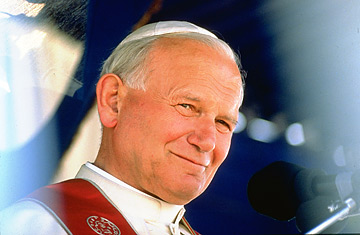
Pope John Paul II.
The first response is that subito is a relative term here in Rome, as well as in the long view of the Church's 2,000-year history. Pope Benedict XVI has indeed moved about as quickly as he could have, short of simply tossing aside the procedures that have long guided the making of saints. Just 41 days after John Paul's death in 2005, Benedict waived the normal five-year waiting period to begin the process, the first of several signs that the Polish pontiff is almost certainly headed for a record-breaking rise to sainthood. John Paul himself had granted the same exemption to the popolarissima Mother Teresa of Calcutta, who currently stands as the fastest to attain beatification (the last step before sainthood), just six years after her 1997 death. The most rapid rise to sainthood to date is Opus Dei founder Josemaria Escriva de Balaguer, who in 2002 was canonized 27 years after he died.
The crowds who still chant John Paul's name in St. Peter's Square, and the countless individuals praying to his soul, are counting on him reaching those two respective thresholds faster than either Mother Teresa or Escriva. Polish President Lech Kaczynski said Monday that he understood from an oblique response from Vatican Secretary of State Tarcisio Bertone that John Paul would be made a saint by 2010. A more credible hint that the wait will be relatively short was Benedict's declaration Monday that "in the communion of saints, it seems we can hear the living voice of our beloved John Paul II, who from the house of his father, we are sure, continues to accompany the Church." In other words, for the current Pope, John Paul is already among the chosen few.
Benedict knows that the widespread love and admiration for his predecessor is a resource for encouraging the faithful — and apparently himself as well — and should not be bogged down by the full weight of Vatican procedures. Still, for someone who spent more than 20 years as a top Vatican official before rising to the papacy, Benedict is not one to lightly brush aside the Holy See's bureaucratic rigor. He indeed has the authority to proclaim John Paul a saint when he sees fit, but that risks setting a precedent — that emotional cries from the piazza can supplant the sacred rules and will of the institution of the Church.
Still, canonization causes do often begin with popular movements, and are brought forth from the diocesan level of the Church hierarchy to the Holy See for consideration. John Paul's cause is being presented by the dioceses of both Rome and Krakow, where he was Archbishop. This week they presented mounds of evidence of his virtues, and at least one miracle said to be credited to his intercession, to the Congregation for the Causes of Saints. Officials will study the case of Sister Marie Simon-Pierre, a 46-year-old French nun diagnosed with Parkinson's Disease — the same illness that afflicted the late Pope — that inexplicably disappeared two months after John Paul had died. The typical procedure to verify a person's saintliness includes the equivalent of a trial, which includes a lawyer arguing against the cause (who gave name to the expression the "Devil's Advocate"), and doctors testifying to the proof that purported miracles have no scientific explanation. A post-mortem miracle must be verified to reach beatification, and a second for canonization.
John Paul signed off on more beatifications (1,340) and canonizations (482) than all his modern predecessors combined. Benedict may be slowing down the process. While John Paul's, Mother Teresa's and other cases march forward in the dark offices of the Vatican, it is in the light of day that we see a subtle shift on sainthood policy in this papacy. Yes, most of the valid causes already under way are moving forward, but Benedict has decided to no longer preside over the beatification ceremonies in St. Peter's as John Paul had done. Later this month, in three separate Italian cities — Turin, Castellammare di Stabia and Rimini — local bishops will beatify three respective local figures, without the presence of the Pope. The faithful can be assured, however, that there is at least one likely beatification ceremony on the horizon that Benedict won't want to miss.
